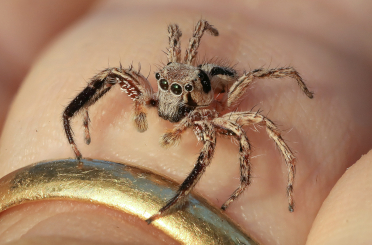- Series:Animals, Transcript English
Isaiah 59:5
“They hatch cockatrice’ eggs, and weave the spider’s web: he that eateth of their eggs dieth, and that which is crushed breaketh out into a viper.”
 Spiders are unpleasant enough without seeing them jump. But there is a whole family of jumping spiders, which is enough to terrify even the mildest arachnophobe.
Spiders are unpleasant enough without seeing them jump. But there is a whole family of jumping spiders, which is enough to terrify even the mildest arachnophobe.
But before I get sidetracked into a whole rant about how I don’t like spiders, I have to admit that one of their most well-known properties is their ability to stick to vertical surfaces, and even to upside down surfaces, seeming to defy the laws of gravity. In order to hang upside down from the ceiling, it is clear that there must be some sort of mechanism whereby some spiders can attach their feet to even the smoothest surfaces. And this brings us back to jumping spiders because scientists have carefully analyzed the structure of the feet of the jumping spider Evarcha arcuata.
To make this analysis, scientists used a scanning electron microscope – one of the most powerful microscope devices available. Microscope images first showed that the spiders’ feet were divided into hair-like structures. So they zoomed in on the hairs and found that each of those divided into even smaller hairs at the ends. The ends of these little hairs, or setules, are tiny triangles, with an area of 1.7 x 105 nm2. These are almost as small as the molecular level, so they can stick to a surface by the inter-molecular van der Waal’s forces. This incredibly detailed design could not have come about by chance; it is illustrative of the wonderful design of our Creator God.
Prayer: Thank You, Lord for the wonders of Your creation and the marvelous creatures that You have made. Amen.
Author: Paul Taylor
Ref: Sarfati, J., Spectacular Spider Stickiness, Creation 27(4):54–55, September 2005. Image: CC BY-SA 4.0 International.
© 2020 Creation Moments All rights reserved.
